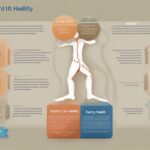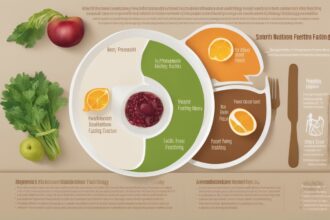Fasting has become a popular health practice, whether for weight loss, spiritual reasons, or metabolic benefits. But what happens when the fast ends? How do you transition back to regular eating without shocking your system or undoing the benefits of your fast? This is where refeeding after fasting comes into play. It’s not just about eating again; it’s about doing so strategically to protect your health and optimize recovery. In this comprehensive guide, we’ll dive into the science behind refeeding, explore practical strategies for breaking a fast, and provide actionable tips to ensure a smooth transition. Whether you’ve completed a short intermittent fast or an extended water fast, understanding how to refeed properly is crucial. Let’s explore how to nourish your body the right way after a period of abstinence.
What Is Refeeding After Fasting, and Why Does It Matter?
Refeeding after fasting refers to the process of reintroducing food to your body after a period of reduced or no caloric intake. This isn’t as simple as grabbing a burger and fries the moment your fast ends. During fasting, your digestive system slows down, and your body shifts into a state of conservation, relying on stored energy like glycogen and fat. Suddenly overloading it with heavy meals can lead to discomfort, bloating, or even serious health risks like refeeding syndrome—a potentially fatal condition involving electrolyte imbalances (Kalantar-Zadeh et al., 2016). Proper refeeding ensures your body adjusts gradually, replenishing nutrients without overwhelming your system. It’s especially critical after prolonged fasts (lasting more than 3–5 days), where the risk of complications is higher. Understanding this process can help you avoid pitfalls and maximize the benefits of fasting, such as improved insulin sensitivity and cellular repair.
The Science Behind Refeeding: What Happens to Your Body?
When you fast, your body undergoes significant metabolic changes. Initially, it depletes glycogen stores in the liver and muscles for energy. After about 24–48 hours, it shifts to ketosis, burning fat for fuel (Cahill, 2006). During extended fasts, your body also downregulates digestive enzymes and gut activity to conserve energy. When you start eating again, insulin levels spike, and your body begins to shift back to carbohydrate metabolism. This sudden change can cause a rapid uptake of electrolytes like phosphorus, potassium, and magnesium into cells, leading to dangerous imbalances if not managed properly (Mehanna et al., 2008). That’s why a gradual approach to breaking a fast is essential. Research shows that a controlled refeeding process can prevent these shifts and support a smoother metabolic transition, reducing stress on your organs (Friedli et al., 2017). Knowing how your body responds helps tailor your refeeding plan to your specific fasting duration and health status.
Key Principles for Safe Refeeding After Fasting
Whether you’ve done a 16:8 intermittent fast or a multi-day water fast, following some core principles can make refeeding safer and more effective. The goal is to ease your digestive system back into action while replenishing essential nutrients. Here are some foundational guidelines to keep in mind when planning your post-fast nutrition:
- Start Small: Begin with small portions to avoid overwhelming your stomach. Think broths, soups, or light snacks rather than full meals right away.
- Prioritize Hydration: Rehydrate with water or electrolyte-rich fluids before eating solid food, as fasting can deplete fluid levels.
- Focus on Easily Digestible Foods: Choose foods low in fiber and fat initially, like bananas or boiled vegetables, to minimize digestive strain.
- Monitor Your Body: Pay attention to how you feel—stop eating if you experience nausea, bloating, or discomfort.
These principles apply broadly, but the specifics of your refeeding plan should depend on the length and type of fast you’ve completed. Let’s break down tailored strategies next.
Refeeding Strategies Based on Fasting Duration
Not all fasts are created equal, and neither are the refeeding approaches. The longer the fast, the more cautious you need to be when reintroducing food. Below, we’ll outline strategies for different fasting durations to ensure a safe transition back to regular eating.
For short-term fasts like intermittent fasting (12–24 hours), refeeding can be relatively straightforward. Start with a light meal containing protein, healthy fats, and complex carbs—think a small serving of eggs with avocado on whole-grain toast. Avoid sugary or processed foods that could spike blood sugar too quickly. Since your digestive system hasn’t been dormant for long, you can often resume normal eating within a few hours.
For medium-duration fasts (2–3 days), take a more gradual approach. Begin with clear liquids like bone broth or vegetable stock for the first 4–6 hours. Then, introduce soft, cooked foods like mashed sweet potatoes or oatmeal. Keep portions small and spread meals out over the day to avoid overloading your gut. It may take 1–2 days to return to your regular diet.
For extended fasts (5+ days), extreme care is needed due to the risk of refeeding syndrome. Medical supervision is often recommended, especially if you have underlying health conditions. Start with very small amounts of diluted juice or broth every few hours on the first day. Gradually increase to pureed fruits or vegetables over 2–3 days before adding proteins or grains. Full recovery to normal eating might take a week or more (Crook et al., 2001). Regardless of fasting length, listen to your body and adjust as needed during the refeeding process.
Foods to Include (and Avoid) During Refeeding
Choosing the right foods during refeeding can make all the difference in how your body recovers. The focus should be on nutrient-dense, gentle options that support hydration and electrolyte balance. Here’s a breakdown of what to embrace and what to steer clear of during the initial stages of post-fasting recovery:
- Best Foods to Start With: Bone broth or vegetable broth for hydration and minerals; bananas or applesauce for gentle carbs and potassium; cooked carrots or zucchini for easy-to-digest nutrients; plain yogurt for probiotics to support gut health.
- Foods to Avoid Initially: High-fat or fried foods that burden digestion; raw, fibrous vegetables that can cause bloating; sugary snacks or drinks that spike insulin; caffeine or alcohol, which can dehydrate or irritate the stomach.
- Gradual Additions: After a day or two (or longer for extended fasts), introduce lean proteins like chicken or fish, whole grains like quinoa, and healthy fats like olive oil in small amounts.
Remember, the goal isn’t just to eat—it’s to rebuild your energy and nutrient stores without causing distress. Patience is key. Rushing into heavy or processed foods can lead to gastrointestinal upset or undo the metabolic benefits of your fast.
Common Mistakes to Avoid During Refeeding
Even with the best intentions, it’s easy to slip up during the refeeding phase. Many people are eager to dive back into their favorite meals or misjudge how much their body can handle. Being aware of common pitfalls can help you navigate this delicate period. One major mistake is eating too much too soon—overloading your stomach after a fast can cause nausea, cramping, or even vomiting. Another error is ignoring hydration; without proper fluids, digestion becomes harder, and electrolyte imbalances can worsen. Skipping medical advice for extended fasts is also risky, as refeeding syndrome can be silent but deadly if nutrient levels drop dangerously low (Boateng et al., 2010). Lastly, don’t neglect mindfulness—eating slowly and chewing thoroughly aids digestion and helps you tune into hunger cues. By avoiding these traps, you’ll set yourself up for a smoother transition after fasting.
In wrapping up, refeeding after fasting is a critical step that deserves as much attention as the fast itself. It’s not just about satisfying hunger but about restoring balance to your body in a safe, sustainable way. By starting small, choosing gentle foods, and listening to your body’s signals, you can ensure a successful transition back to regular eating. Whether you’re a seasoned faster or trying it for the first time, a thoughtful refeeding plan can enhance the benefits of fasting while minimizing risks. Remember, every body is different, so tailor these strategies to your needs and consult a healthcare provider if you’re unsure, especially after longer fasts. Here’s to breaking your fast with care and stepping into renewed energy and health!
References
- Boateng, A. A., Sriram, K., Meguid, M. M., & Crook, M. (2010). Refeeding syndrome: Treatment considerations based on collective analysis of literature case reports. Nutrition, 26(2), 156–167. https://doi.org/10.1016/j.nut.2009.11.017
- Cahill, G. F. (2006). Fuel metabolism in starvation. Annual Review of Nutrition, 26, 1–22. https://doi.org/10.1146/annurev.nutr.26.061505.111258
- Crook, M. A., Hally, V., & Panteli, J. V. (2001). The importance of the refeeding syndrome. Nutrition, 17(7–8), 632–637. https://doi.org/10.1016/S0899-9007(01)00542-1
- Friedli, N., Stanga, Z., Sobotka, L., Culkin, A., Kondrup, J., Laviano, A., … & Schuetz, P. (2017). Revisiting the refeeding syndrome: Results of a systematic review. Nutrition, 35, 151–160. https://doi.org/10.1016/j.nut.2016.05.016
- Kalantar-Zadeh, K., Tortorici, A. R., Chen, J. L., Kamgar, M., Lau, W. L., Moradi, H., … & Kopple, J. D. (2016). Dietary restrictions in dialysis patients: Is there anything left to eat? Seminars in Dialysis, 29(2), 159–168. https://doi.org/10.1111/sdi.12449
- Mehanna, H. M., Moledina, J., & Travis, J. (2008). Refeeding syndrome: What it is, and how to prevent and treat it. BMJ, 336(7659), 1495–1498. https://doi.org/10.1136/bmj.a301






